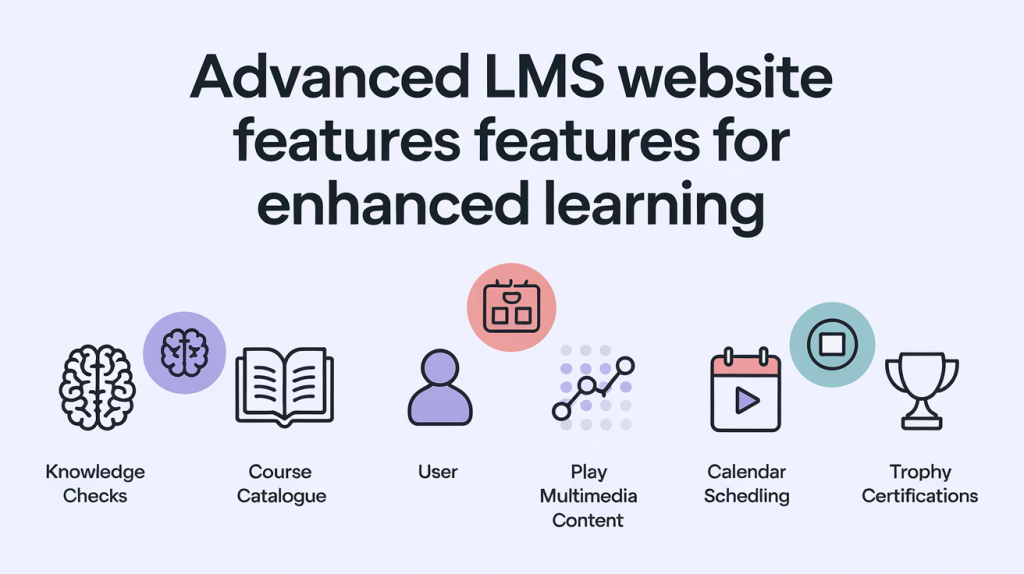As the world of online learning continues to evolve, Learning Management Systems (LMS) are becoming increasingly sophisticated, offering more advanced features to meet the growing demands of learners and educators. In today’s competitive LMS market, simply providing a platform for course delivery is no longer enough. To stand out and attract more users, you need to integrate features that enhance engagement, streamline learning, and offer personalized experiences. We’ll explore some of the most advanced LMS website features that can help you stay competitive. Whether you’re a business offering corporate training or an educational institution seeking to engage your students, these features will elevate the user experience and improve learning outcomes.

The Growing Importance of Advanced Features in a Competitive LMS Market
The learning landscape has shifted, and users now expect more than just basic functionality from an LMS. Advanced features not only make your LMS more appealing to learners but also provide instructors with powerful tools for delivering content and tracking performance. These innovations can help increase engagement, retention, and satisfaction, giving you a distinct edge in a crowded market.
But what exactly are these advanced LMS features? Let’s dive into the top features that are redefining how learning platforms work today.
Suggested Posts:
1. Gamification
Adding Elements like Points, Badges, and Leaderboards to Enhance Engagement
Gamification has emerged as one of the most popular trends in LMS design, as it taps into learners’ intrinsic motivation. By adding game-like elements, such as points, badges, leaderboards, and achievement levels, LMS platforms transform the learning process into an interactive, fun experience.
How Gamification Boosts Motivation and Completion Rates
The primary benefit of gamification is its ability to motivate learners. Gamification helps to create a sense of accomplishment, offering rewards for completing tasks, reaching milestones, and achieving learning goals. This not only keeps learners engaged but also drives them to finish courses and stay on track.
- Points: Reward learners with points for completing assignments, quizzes, and other activities, offering incentives to progress further.
- Badges: Award badges as learners achieve specific milestones or complete challenges, making their progress visible.
- Leaderboards: Display leaderboards to foster healthy competition and encourage learners to keep improving.
By introducing a game-based learning environment, learners feel more invested in their progress and are more likely to complete their courses.

2. Social Learning and Collaboration
Integrating Social Learning Tools (Forums, Chat, Group Projects)
Social learning is all about creating a collaborative environment where learners can interact with each other, share ideas, and solve problems together. With integrated social learning tools, such as forums, chat groups, and group projects, learners can learn from their peers in ways that mimic real-world interactions.
How Peer-to-Peer Learning Enhances the Educational Experience
Peer-to-peer learning offers immense benefits, including diverse perspectives, motivation from colleagues, and enhanced problem-solving. Social learning tools encourage students to participate in discussions, ask questions, and collaborate on assignments, thus creating a sense of community and connection.
- Discussion Forums: Encourage learners to participate in forum discussions to deepen their understanding of the course material.
- Group Projects: Enable collaborative work on projects, allowing learners to apply their knowledge while learning from others.
- Peer Reviews: Integrate peer review systems where students can assess each other’s work, providing valuable feedback and reinforcing their learning.
By fostering collaboration and social interaction, LMS platforms can create a more engaging and effective learning environment.
3. Advanced Reporting and Analytics
Tracking Learner Progress with Detailed Reports
Advanced LMS platforms offer robust reporting and analytics tools that provide both educators and administrators with detailed insights into learner performance. These tools can track everything from course completion rates to quiz scores, giving you a clear picture of how well learners are progressing.
Using Analytics to Improve Course Delivery and Learner Outcomes
Analytics go beyond just tracking grades—they provide actionable insights that can help you improve course delivery and enhance the learning experience. Educators can identify patterns, pinpoint struggling learners, and make data-driven decisions to improve course content or structure.
- Real-Time Progress Tracking: Monitor how learners are progressing throughout a course and intervene when necessary.
- Performance Dashboards: Provide instructors with visual dashboards to easily track learner engagement and completion rates.
- Custom Reports: Generate reports based on various metrics (such as quiz performance, time spent on tasks, etc.) to assess the effectiveness of the course.
By leveraging analytics, you can personalize learning experiences, improve student outcomes, and continuously optimize your LMS.
Suggested Posts:
4. AI and Personalization
How AI Can Offer Personalized Learning Paths
Artificial Intelligence (AI) is revolutionizing online learning by offering personalized experiences for learners. By analyzing learner behavior and performance, AI can dynamically adjust the learning path for each individual, ensuring that they receive the right content at the right time.
AI-powered LMS platforms can recommend courses, quizzes, and additional resources based on the learner’s interests, learning pace, and performance. This level of personalization not only enhances the learner’s experience but also increases their chances of success.
- Adaptive Learning: AI can adjust the complexity of the material based on how well the learner is progressing, ensuring a tailored learning journey.
- Automated Recommendations: Suggest relevant courses and content based on a learner’s past interactions with the platform.
By incorporating AI, LMS platforms can create smarter, more effective learning paths that keep learners engaged and on track.
5. Multi-Language and Multi-Currency Support
Importance of Reaching a Global Audience
In today’s globalized world, online learning is no longer confined to a single region or language. Offering multi-language support enables you to cater to a wider audience, ensuring that learners from different backgrounds can access and benefit from your courses. Additionally, multi-currency support allows you to reach learners across the world, making it easier for them to pay for courses in their local currency.
Setting Up LMS for International Learners
LMS platforms with multi-language and multi-currency support provide a seamless experience for international learners. Here’s how:
- Multi-Language Support: Allow learners to choose their preferred language for course content, navigation, and communication.
- Currency Conversion: Enable users to pay for courses in their local currency, simplifying the purchasing process.
By making your LMS platform accessible to international learners, you expand your reach and create a more inclusive learning environment.
6. Integration with Third-Party Tools
Connecting to External Apps (Zoom, Google Drive, Dropbox, etc.)
Integrating your LMS with third-party tools can enhance its functionality, providing a seamless experience for both learners and instructors. Whether you want to integrate video conferencing tools, cloud storage, or other productivity apps, third-party integrations can help streamline operations and improve user experience.
Payment Gateways, CRM, and Email Marketing Integrations
For businesses and course creators, integrating payment gateways allows for smooth course purchases, while CRM systems help manage relationships with learners. Email marketing integrations enable automated communication with learners, such as reminders, updates, and newsletters.
- Zoom Integration: Use Zoom for live virtual classes, webinars, and instructor-student interaction.
- Google Drive/Dropbox Integration: Allow learners to access course materials stored on cloud platforms.
- CRM Integration: Track learner engagement and manage communications through a customer relationship management system.
These integrations help centralize resources and improve operational efficiency, offering both learners and instructors a seamless learning experience.
Key Takeaways:
Advanced LMS website features are not just about adding fancy tools—they are about enhancing the learning experience, improving engagement, and achieving better outcomes for learners. By integrating features like gamification, social learning, advanced analytics, AI-powered personalization, and multi-language support, you can create a platform that caters to diverse needs and stays ahead of the competition.
As the demand for online learning continues to grow, staying competitive means offering a robust, feature-rich LMS that meets the needs of today’s learners and educators. Embrace these advanced features to build a dynamic, effective, and future-proof LMS platform.
- Gamification enhances motivation and engagement through rewards and competition.
- Social learning tools foster collaboration and peer-to-peer learning, improving the educational experience.
- Advanced reporting and analytics help track progress and optimize course delivery.
- AI-powered personalization offers tailored learning paths, improving learner outcomes.
- Multi-language and multi-currency support expand your LMS’s reach to a global audience.
Third-party integrations streamline operations and improve the user experience.
